They are mowing wheat
Through the heavy days;
Through the silent heat
They are mowing wheat;
Flat fields retreat
Into shrouding haze;
They are mowing wheat
Through the heavy days.
Frances Cornford, Harvest
Balancing fun with straw bales (above) and barley ears scattered for the gleaners (below). These days it’s mostly pigeons I think, but once it would have been the women who came out with their baskets to gather every precious ear. Not that this many would have been left on the ground when everything was done by hand!
Hello lovely friends, and a happy new moon in Leo. What a golden new moon it is!
These few days are packed with meaning for me. Monday (14 August) was Old Lammas. Before the calendar changed in 1752 and we lost 11 days (which has now crept to 13), Lammas, feast of first fruits, would have taken place at this exact point in the year.
I don’t know about you, but I think the season is feeling decidedly different now to how it did a fortnight ago. Everywhere around me here at The Old Shop I notice the gently reddening haws and bruised hues of the sloes. More insistent are the rumble of combine harvesters, the rising mist of golden dust and the rattle of bale-laden tractors hurtling down my narrow lane and startling the sparrows out of their hedge.
Are you noticing the subtle seasonal changes too?
Tuesday 15 August was The Feast of the Assumption, when according to Christian belief the Virgin Mary was bodily transported to heaven. It’s also entwined with many a harvest custom. Mary becomes, in a sense, an avatar for a much older impulse connected with gathering in the fruits of the land and turning its sacred plants into protective talismans. In Poland this is the Day of the Divine Mother of Herbs and the Feast of Our Lady of the Greens, when herbal bouquets filled with cereals, herbs, vegetables and flowers are brought into the church and blessed.
I was amazed to read that these bundles are meant to contain the nine sacred herbs associated with the Nine Orders of Angels: chamomile, nettle, fennel, crabapple, mugwort, plantain, watercress, chervil and betony. If you’re familiar with the Anglo-Saxon Nine Herbs Lay with its written charms for each herb you will have noticed how closely these traditionally protective Polish herbs relate to them! I would never have imagined such a close link between pagan Anglo-Saxon and Catholic Eastern European practices but that’s what makes research - and serendipitous discoveries -so fascinating.
Once blessed, these herbs were - and are - woven into wreaths to be hung near religious icons, or within homes to be readily available for use against illness and also for cattle and field blessing rituals. Indeed, their mere presence is believed to ward off misfortune and natural disaster.
And yes, the tradition of the blessing of the herbs in Polish churches on 15 August continues to this day.
In a similar vein, @forest.whisperer on Instagram sees Mary as a cyclic vegetation deity:
Her assumption and transformation echoes the harvest season of the peasants that worshipped her. Mary dies as the crop dies in autumn, but neither return to the earth to decompose. Instead they are transformed into sustenance for her people. Like the grain metamorphosing into bread and beer, Mary lives on in a new form. She is taken up into heaven just as we take up the herbs into our bundles. Like Mary rising into the sky, the sacred herb bundles tied on the day of her assumption cannot be composted. They must be released into the heavens with fire. Like Mary, they undergo a miraculous transformation into medicine, magic, and smoke that rises into the sky.
Of course, if I’m insistent that Old Lammas is a more significant marker than the date in the current calendar, the same has to be true of Old Assumption. And the season and its atmosphere will certainly have moved on substantially by 28 August. Years ago I did a whole art project about Assumption, elderberries and the traditional roles of women, but there’s so much material that I think I’ll assemble it into an essay for my paid subscribers ‘between the moons’ as otherwise it will take up this whole newsletter. Meanwhile, there’s plenty for us to explore.
Herbal smoulder sticks made on 15 August 2023 (before I knew of the Polish custom - serendipity again!).
And today, 16 August, well, that brings us to where we started, the new moon in Leo. A time when summer and autumn sing together on a knife edge, a liminal moment, surely the dream opportunity for potent intentions to be set.
But let’s dwell on Old Lammas awhile. Last year I made a whole video about Old Lammas and I thought I couldn’t really do better than to link it below. Among other things, you’ll see me threading a protective rowan berry string and preparing blackberry tincture.
And - sorry if this feels like cheating! - the now-traditional Bracken & Wrack recipe is also demonstrated here in the video. I’ll include a photo of the completed Lammas Pudding at the end of this newsletter to remind you, just in case you’d like to try it.
In that open field
If you do not come too close, if you do not come too close,
On a summer midnight, you can hear the music
Of the weak pipe and the little drum
And see them dancing around the bonfire
The association of man and woman
In daunsinge, signifying matrimonie -
A dignified and commodious sacrament.
Two and two, necessary conjunction,
Holding eche other by the hand or the arm
Whiche betokeneth concorde. Round and round the fire
Leaping through the flames or joined in circles,
Rustically solemn or in rustic laughter
Lifting heavy feet in clumsy shoes,
Earth feet, loam feet, lifted in country mirth
Mirth of those long since under earth
Nourishing the corn. Keeping time,
Keeping the rhythm in their dancing
As in their living in the living seasons
The time of the seasons and the constellations
The time of milking and the time of harvest
The time of the coupling of man and woman
And that of beasts. Feet rising and falling.
Eating and drinking. Dung and death.
T S Eliot, from East Coker in Four Quartets
Rowan and Sloe
Sloes ripening along the lane towards the heath.
The sight of rowan branches bending under the weight of their berries and the ripening sloes on the blackthorns along the lane reminded me of this mandala cloth I made a few years ago. With the heat gone out of the lowering sun and fabulous golden light developing I thought I’d take it over to the heath and unfurl it among the bracken and birch. Reading a little about the incredible history and healing/spiritual significance of the mandala form has inspired me to start thinking circular again.
Circles are so much a part of our own archaeology too. My archaeologist husband and I must have sat on practically all the henges, causewayed enclosures and prehistoric burial mounds in Norfolk, whether or not there was anything to be seen of them above ground.
The little rowan and blackthorn hearth I designed and made a few years ago. It was really fun to work out how to represent the leaves, flowers and berries! Around the edge are sewn bone beads in honour of the ancestors. Photographed in Crow Wood.
Two Years Ago: The Fairy Queen
When I began working in the tiny cottage garden last year, I set out nine echinacea pallida plants. To say they flourished would be overstating the case, but they did seem to hang on in there until they and all the other herbaceous plants withdrew into the earth for their winter slumber. However, newly-emerged echinacea leaves are quite nondescript and with all the excitement this spring as plant after plant returned and stretched itself, yawning, I have to confess I quite forgot about them.
Then, a week or two ago, I noticed a strong, thrusting green stem topped by an unfamiliar flower bud. As stubby, yet ribbony pink petals began to flutter and extend themselves seemingly before my very eyes I remembered what this mystery plant must be. I had swooned over echinacea pallida in photos and had held my breath at the sight of such ethereal grace. A beauty, dare I say, to compete with that of the Fairy Queen herself.
Of those nine plants it seems that only one has survived, and that plant with just a single, utterly joyous bloom.
The swifts will be wheeling away from The Old Shop any day now, but what a late-summer blessing lies within the garden gate.
The last Echinacea, August 2021.
The Creak of Masts
The Norfolk Broads still retain their allure even in the busy holiday season and I’m lucky enough to have friends who are the proud owners of La Mouette, a small vintage boat. We meandered from Potter Heigham to Thurne and back, brewing copious cafetières in the tiny galley and stopping off at Ludham Marshes for a walk, where I gathered handfuls of wild damsons for jelly. I need to go back at dusk one day to watch barn owls quartering the marsh. The sea and the heath may be nearer for everyday magic, but the whispering reeds and willows, the horizons punctuated only by sails, the creak of masts and the shimmer of water will always call me back.
Mill on the River Thurne, Norfolk.
Teasel
The wild churchyard of a lonely medieval church almost within sight and sound of the sea. It was misty and a bit drear to be honest but I really fancied some blackberries to make a warming crumble for supper and I knew that the graveyard brambles were laden with purple juiciness. The churchyard has been left un-mown for conservation reasons (hooray!) and myriad wild grasses and flowers now hold away. Teasel, toadflax, lady’s bedstraw, yarrow, mugwort, plantain, dock, field poppy and ox-eye daisy were just a few of the delicate beauties that caught my eye, some of these already skeletal, stark reminder of the fragility of summer.
Churchyard at Lessingham, Norfolk.
On Monday evening I went down to the meadow. The weathered old gate is overhung now with juicy blackberries, vivid honeysuckle and elderberries already tinged with purple. I had gone there to mark Old Lammas by lighting Kestrel’s Eye, the candle I made for Lammas last year.
Wishing you a fruitful and golden Autumn.
Until next time,
With love, Imogen x
(Just a quick reminder of that Lammas Pudding!)
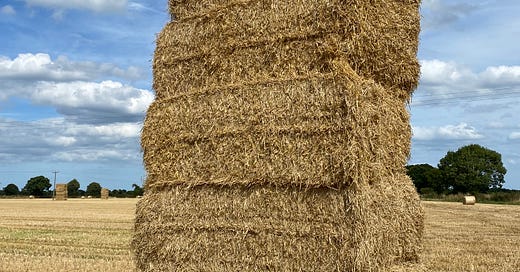




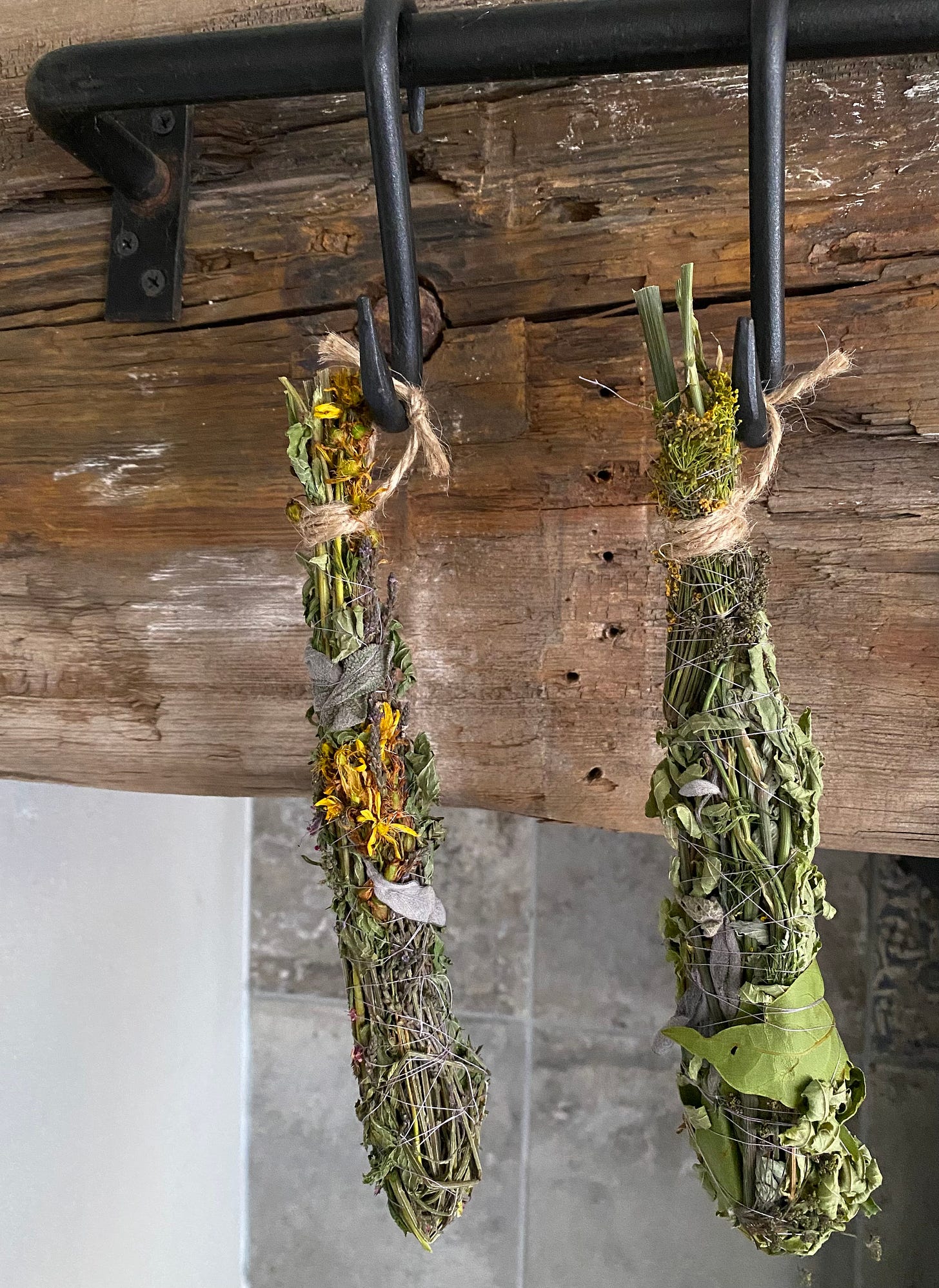
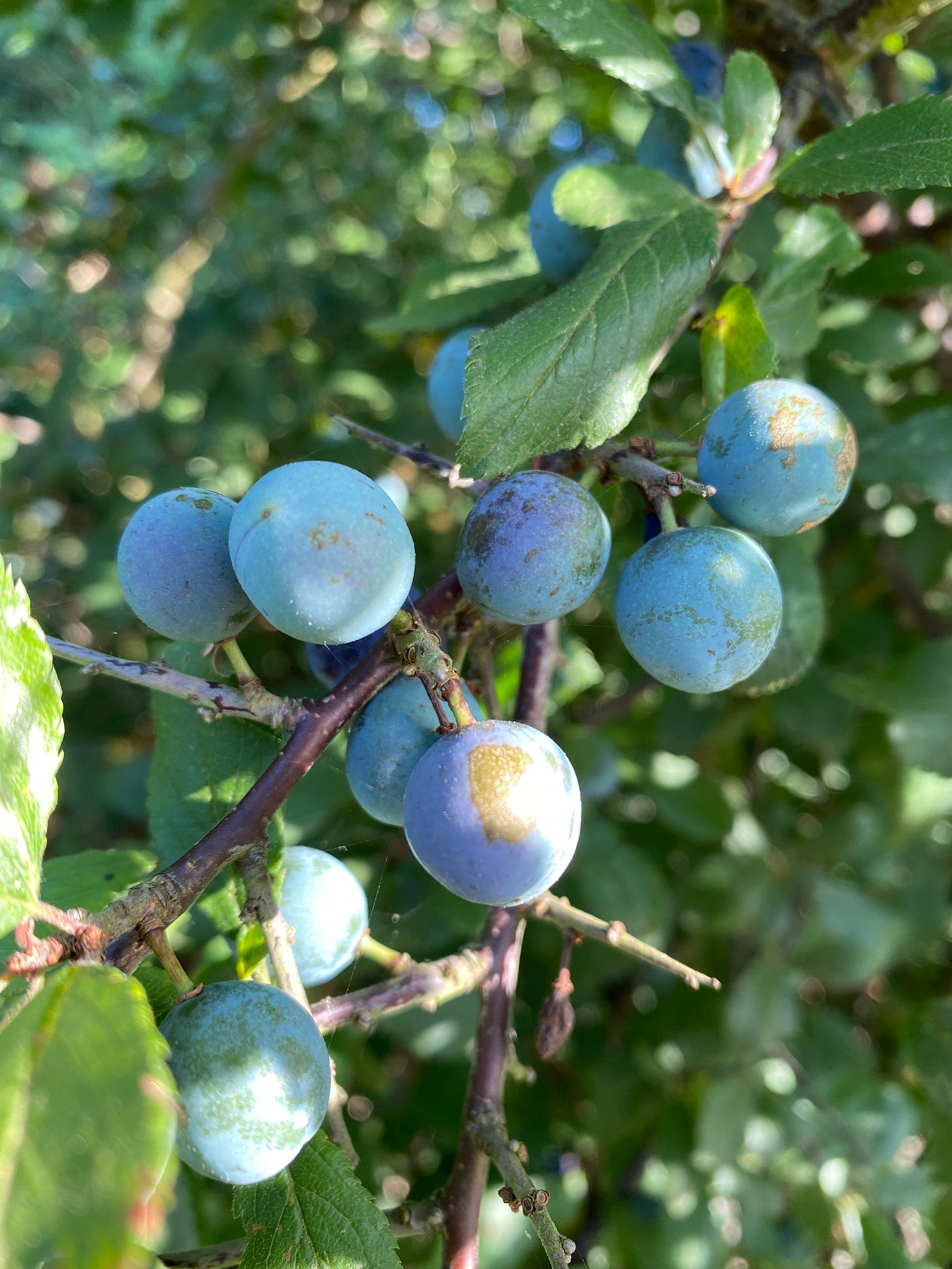

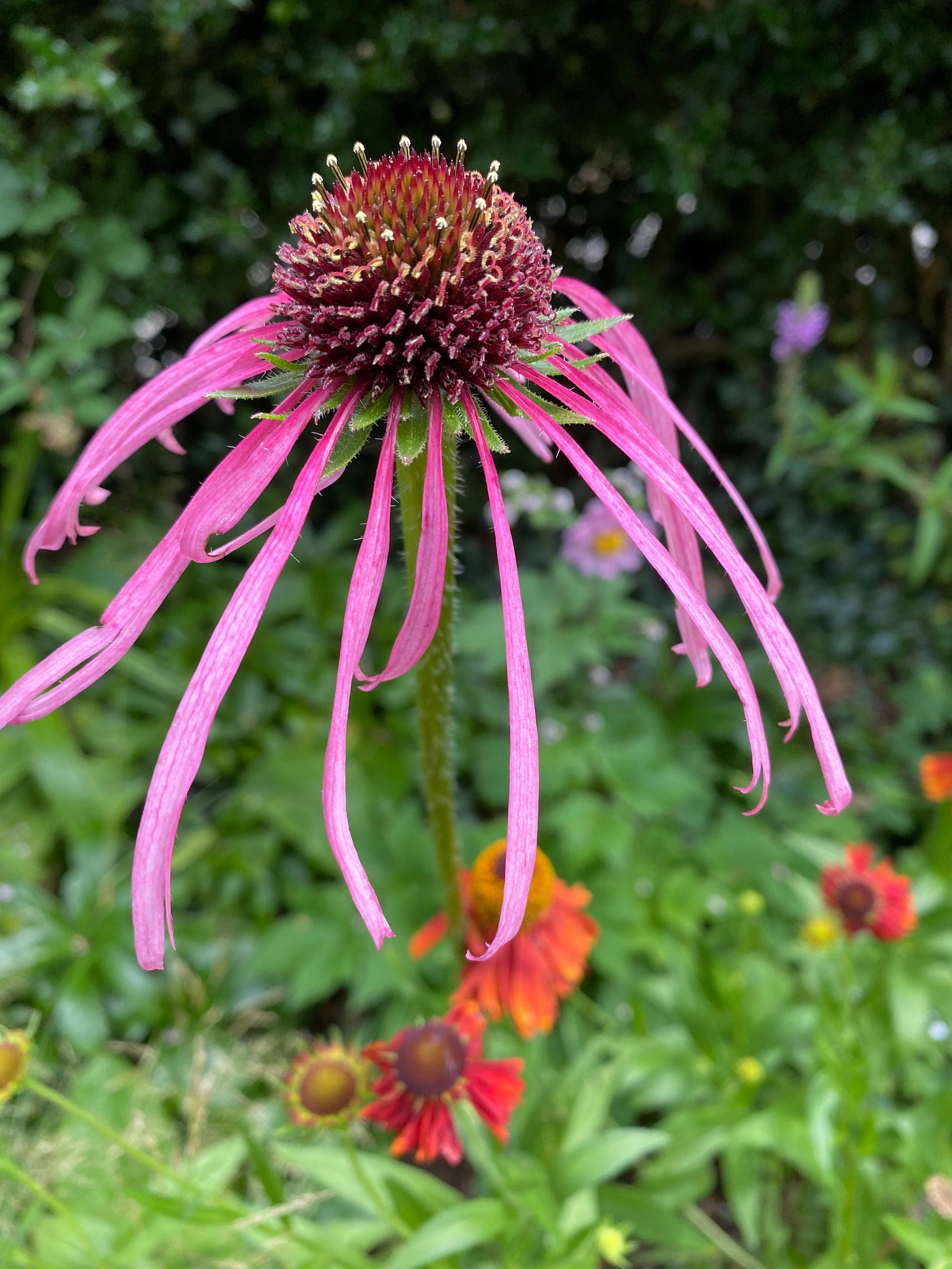

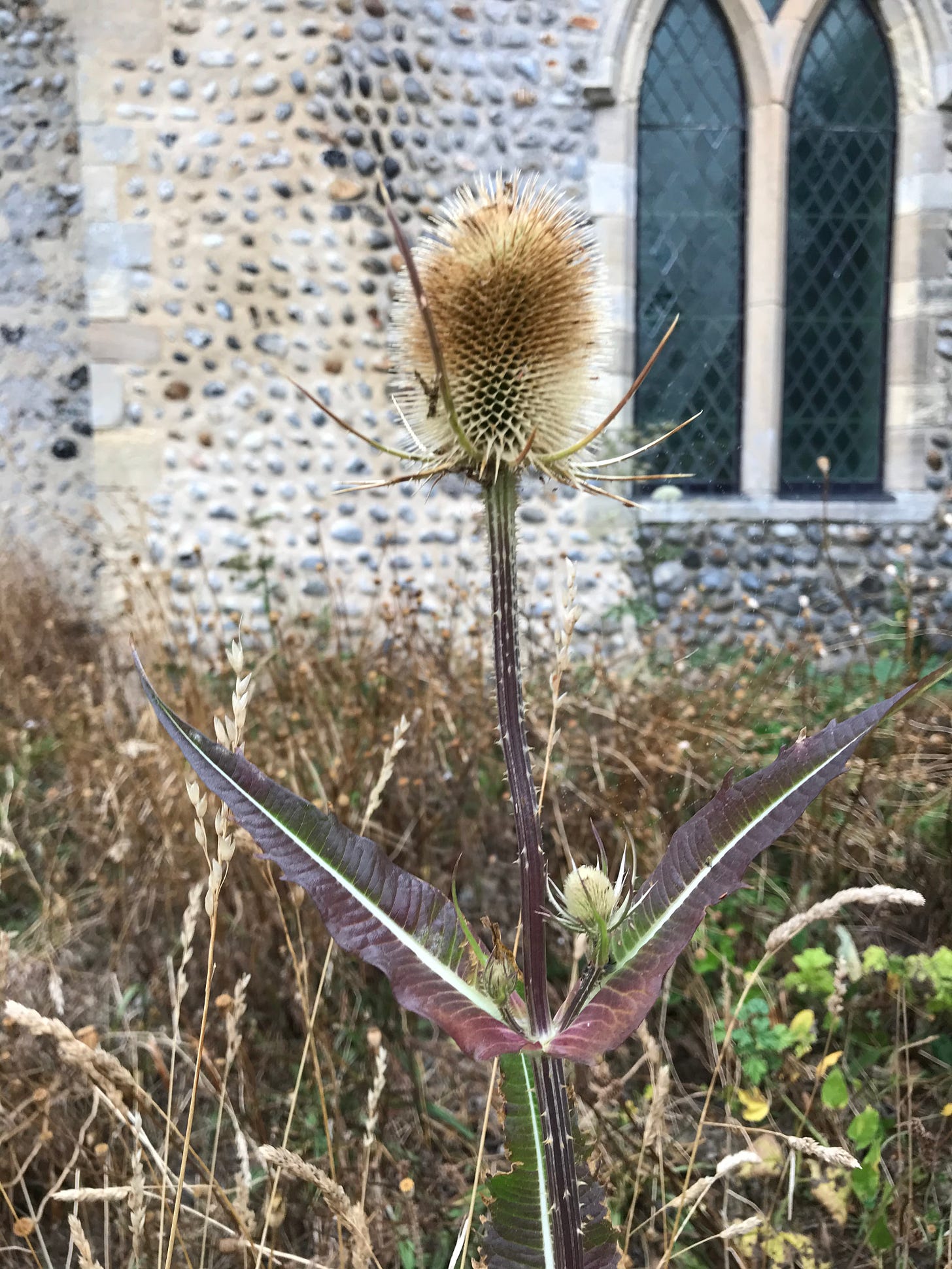
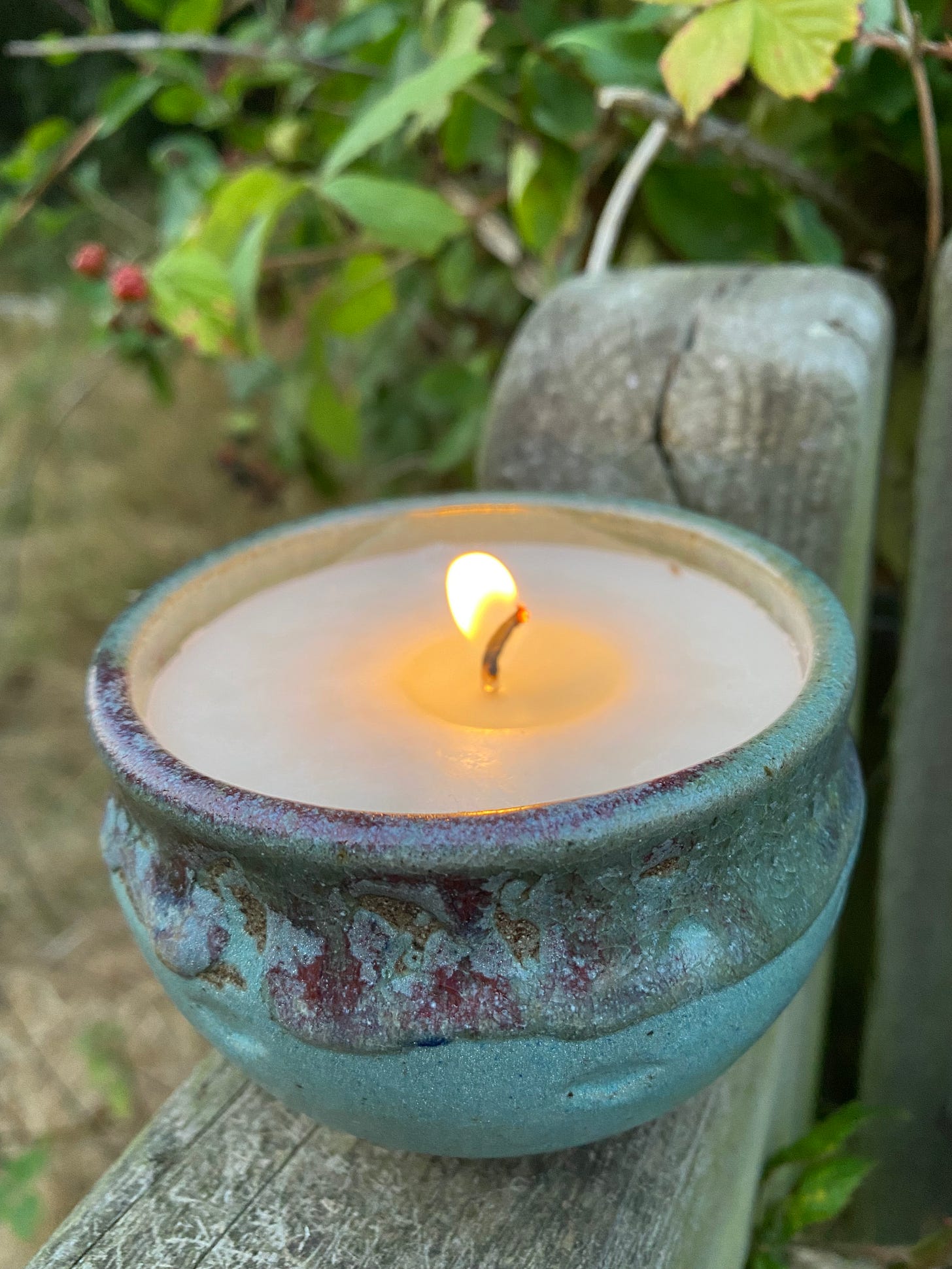

Thank you Imogen, for the glimpse of the near end of one season….another is surely just around the bend. You manage so wonderfully to share the golden endings. Blackberries are my favourite fruit! My mum used to tell me to pick some and I loved doing this. I was alone, in the buzzing heat but my feet were in tall grasses usually in a deep ditch. I could hear birds within the bramble growth and sometimes a frog. I came back triumphant with a full bowl, purple lips and plenty of scratches! Tomorrow there would be jam! Your sloe and hawthorn hearth mandala is beautiful!
Thank you so much for a beautiful and evocative read.This is my favourite time of the year late summer and Autumn. We live on the banks of the Red river in Winnipeg Canada. The season changes are happening here amidst crushing forest fire smoke. I saw a new Lilac blooming in mid-August ! and
beautiful guelder rose berries ripening. The fruits and growth here are amazing because of the early June heat and steady rainfall ( for us at least) other parts of the country are parched.
Many thanks for your cheery and lovely reads I always look forward to them
Love from the prairies
Denise xo